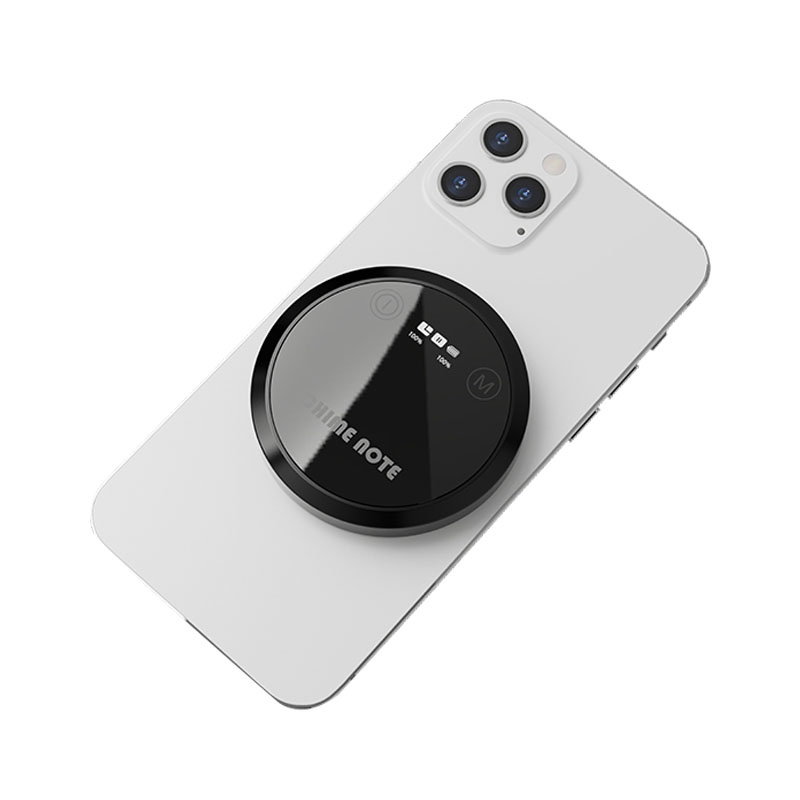How do AI voice recorders achieve clear, distant audio capture using multi-microphone arrays and beamforming technology?
Release Time : 2025-09-24
In a conference room, at the back of a classroom, or during a noisy street interview, traditional recording devices often struggle to capture clear audio. Background noise, reverberation, and distance attenuation make the recordings unclear. The secret behind modern AI voice recorders' ability to "hear" key conversations in these complex environments lies not in a more sensitive single microphone, but in the synergistic operation of multiple microphones and beamforming technology, creating an "actively focused" audio system—like a high-powered telescope for sound.
The multi-microphone array is the foundation of this system. AI voice recorders typically have two or more microphones strategically positioned within the device. These microphones don't work independently; they function as a coordinated network, capturing sound waves from all directions. Since sound travels through air, there's a slight time difference in when the same sound reaches different microphones. This "time difference" is precisely captured by the recorder's processor, providing crucial information about the sound source's location. By analyzing the phase and amplitude relationships of the signals received by multiple microphones, the system can create a spatial model of the surrounding sound field, identifying the location of different sound sources, such as human voices, air conditioning noise, and footsteps.
Beamforming technology then provides "intelligent focusing." Instead of physically moving the microphones, it uses digital signal processing algorithms to weight and combine sounds from different directions, creating a virtual "sound beam." This acoustic beam can be directed to a specific area, such as the speaker at the center of a conference table or the lecturer at the podium. The system enhances the signal from the target direction while suppressing interfering sounds from other angles. This directional pickup capability ensures that the target voice is captured with high signal-to-noise ratio, even from a distance or in noisy environments.
Even more importantly, beamforming has dynamic tracking capabilities. When a speaker moves or multiple people speak during a meeting, the system can analyze the changing sound source in real time and automatically adjust the beam's direction and width. For example, in a one-on-one interview, the beam can focus on a narrow area to enhance clarity; while in a group discussion, the system can generate multiple beams or expand its coverage to ensure that every participant's speech is fully captured. This flexibility allows the AI voice recorder to adapt to diverse usage scenarios without requiring manual adjustments.
The multi-microphone array also enhances noise suppression. Background noises such as fan noise, traffic noise, or air conditioning hum typically originate from a specific direction or have distinct frequency characteristics, while human speech is concentrated in specific frequency bands and varies with intonation. Through spatial filtering and spectral analysis, the system can identify and attenuate unwanted sound sources, preserving the clarity and naturalness of the voice. Even in open spaces like a coffee shop, the recorder can "filter out" surrounding conversations and music, focusing on the conversation in front of the user.
Furthermore, beamforming and AI voice processing form a closed loop. The high-quality audio input provided by the microphone array serves as a solid foundation for subsequent speech recognition, speaker separation, and content summarization. Clear, pristine audio means lower transcription errors and higher semantic understanding accuracy, enabling the AI to not only "record" sound but also "understand" its meaning.
Ultimately, the combination of a multi-microphone array and beamforming transforms the AI voice recorder from a passive recording device into an active auditory perception system. It no longer blindly captures all sounds, but learns to "selectively listen," precisely targeting the desired sound in a complex acoustic environment. When even whispers from a distance can be clearly captured, and conversations remain intelligible amidst noise, this silent intelligence truly embodies the essence of technology serving humanity—ensuring that every recording is faithful to the original sound.
The multi-microphone array is the foundation of this system. AI voice recorders typically have two or more microphones strategically positioned within the device. These microphones don't work independently; they function as a coordinated network, capturing sound waves from all directions. Since sound travels through air, there's a slight time difference in when the same sound reaches different microphones. This "time difference" is precisely captured by the recorder's processor, providing crucial information about the sound source's location. By analyzing the phase and amplitude relationships of the signals received by multiple microphones, the system can create a spatial model of the surrounding sound field, identifying the location of different sound sources, such as human voices, air conditioning noise, and footsteps.
Beamforming technology then provides "intelligent focusing." Instead of physically moving the microphones, it uses digital signal processing algorithms to weight and combine sounds from different directions, creating a virtual "sound beam." This acoustic beam can be directed to a specific area, such as the speaker at the center of a conference table or the lecturer at the podium. The system enhances the signal from the target direction while suppressing interfering sounds from other angles. This directional pickup capability ensures that the target voice is captured with high signal-to-noise ratio, even from a distance or in noisy environments.
Even more importantly, beamforming has dynamic tracking capabilities. When a speaker moves or multiple people speak during a meeting, the system can analyze the changing sound source in real time and automatically adjust the beam's direction and width. For example, in a one-on-one interview, the beam can focus on a narrow area to enhance clarity; while in a group discussion, the system can generate multiple beams or expand its coverage to ensure that every participant's speech is fully captured. This flexibility allows the AI voice recorder to adapt to diverse usage scenarios without requiring manual adjustments.
The multi-microphone array also enhances noise suppression. Background noises such as fan noise, traffic noise, or air conditioning hum typically originate from a specific direction or have distinct frequency characteristics, while human speech is concentrated in specific frequency bands and varies with intonation. Through spatial filtering and spectral analysis, the system can identify and attenuate unwanted sound sources, preserving the clarity and naturalness of the voice. Even in open spaces like a coffee shop, the recorder can "filter out" surrounding conversations and music, focusing on the conversation in front of the user.
Furthermore, beamforming and AI voice processing form a closed loop. The high-quality audio input provided by the microphone array serves as a solid foundation for subsequent speech recognition, speaker separation, and content summarization. Clear, pristine audio means lower transcription errors and higher semantic understanding accuracy, enabling the AI to not only "record" sound but also "understand" its meaning.
Ultimately, the combination of a multi-microphone array and beamforming transforms the AI voice recorder from a passive recording device into an active auditory perception system. It no longer blindly captures all sounds, but learns to "selectively listen," precisely targeting the desired sound in a complex acoustic environment. When even whispers from a distance can be clearly captured, and conversations remain intelligible amidst noise, this silent intelligence truly embodies the essence of technology serving humanity—ensuring that every recording is faithful to the original sound.







